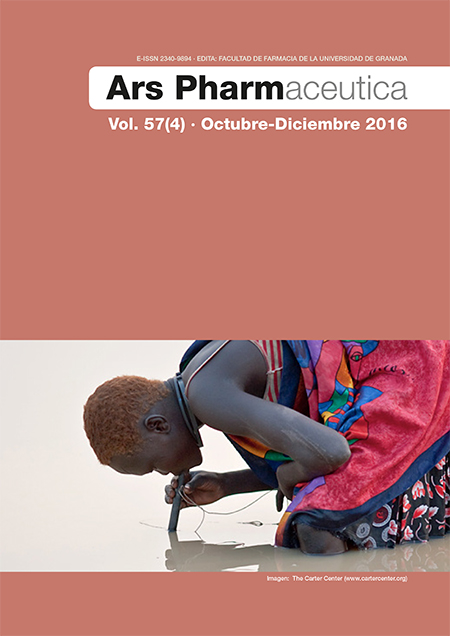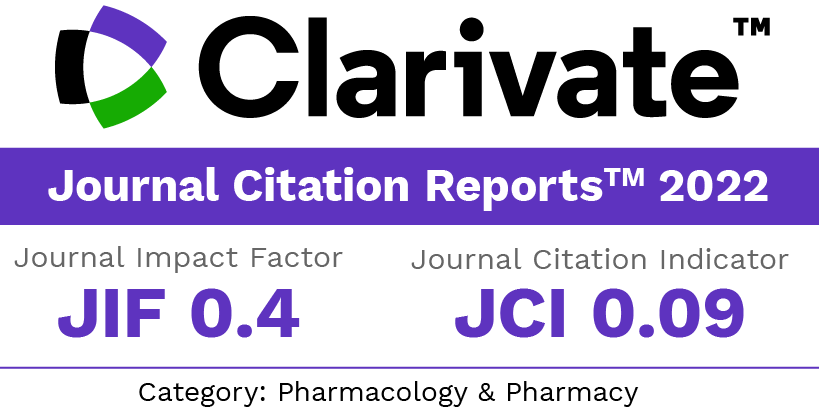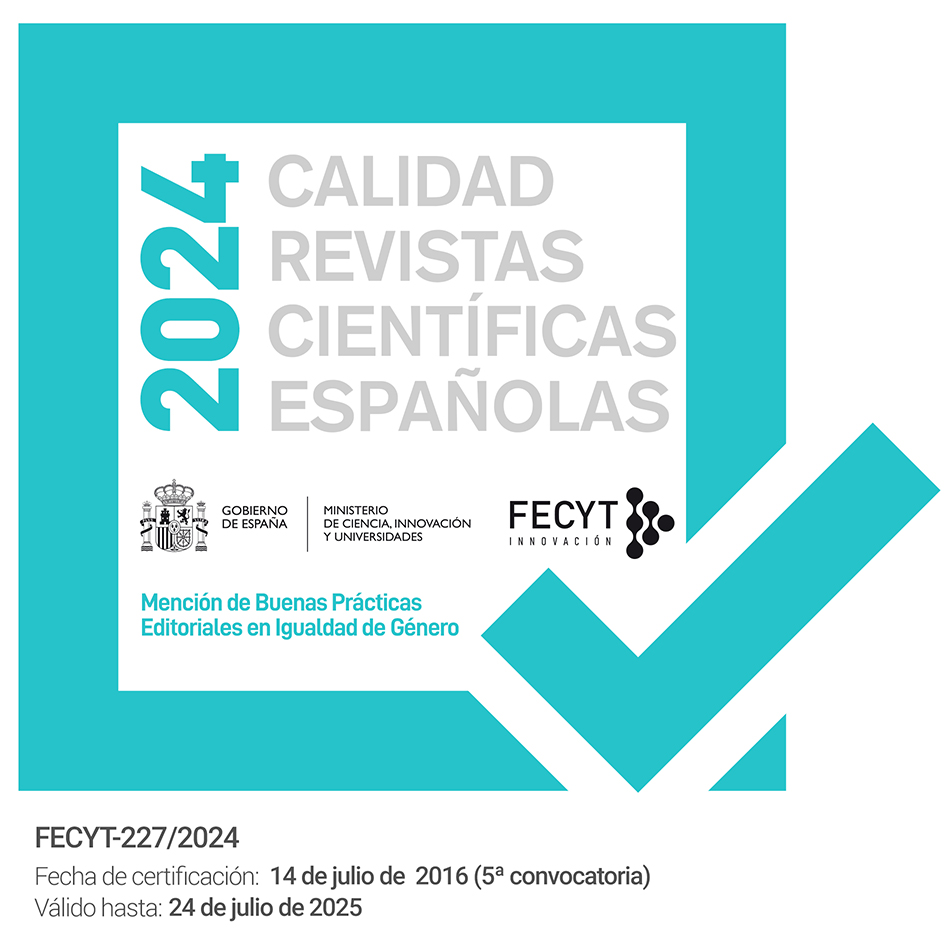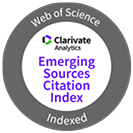Synthesis and cytotoxic activity of tri-acyl ester derivatives of uridine in breast cancer cells
DOI:
https://doi.org/10.30827/ars.v57i4.5560Keywords:
breast cancer, cytotoxic activity, esters synthesis, nucleosides, uridine derivativesAbstract
Aims: Synthesize tri-acyl ester derivatives of uridine, and evaluate its cytotoxicity against breast cancer cells line.
Methods: The tri-esterified uridine derivatives were obtained through Steglich esterification reaction by fatty and aromatic acids, and with acetic anhydride. An acetonide derivative from uridine was prepared with acid catalysis. Compounds were characterized by NMR spectroscopy (1H NMR and 13C NMR), and mass spectrometry. Derivatives were assessed in chinese hamster ovary (CHO-K1) and human breast cancer (MCF-7) cell lines.
Results: Five tri-acyl ester derivatives of uridine were obtained one acetic acid, three fatty acids (myristic acid, stearic acid and oleic acid) with an aromatic acid. The uridine per-acetylated and uridine acetonide were obtained in high yields, however, the tri-acyl ester derivatives of uridine with fatty and aromatic acids were obtained in moderate and low yields, respectively. The acetonide and compounds 2 and 3 exhibited a cell viability inhibition significant on both cell lines to the higher concentration.
Conclusions: Esterification method with coupling agents allowed obtained tri-acyl ester uridine derivatives with aliphatic and aromatic acids. However, significant cytotoxic activity (p<0.05) for uridine and its derivatives was not observed.
Downloads
References
Chik F, Machnes Z, Szyf M. Synergistic anti-breast cancer effect of a combined treatment with the methyl donor s-adenosyl methionine and the DNA methylation inhibitor 5-aza-2′-deoxycytidine. Carcinogenesis. 2014; 35(1): 138-44.
Strasser S, Maier S, Leisser C, Saiko P, Madlener S, Bader Y, et al.. 5-fdurd–AraC heterodinucleoside re-establishes sensitivity in 5-fdurd- and AraC-resistant MCF-7 breast cancer cells overexpressing erbb2. Differentiation 2006; 74(9-10): 488-98.
Silvestris N, Cinieri S, La Torre I, Pezzella G, Numico G, Orlando L, et al.. Role of gemcitabine in metastatic breast cancer patients: A short review. Breast 2008; 17(3): 220-6.
Mehta DR, Foon K a, Redner RL, Raptis A, Agha M, Hou J-Z, et al.. Fludarabine and cytarabine in patients with acute myeloid leukemia refractory to two different courses of front-line chemotherapy. Leuk Res. 2011; 35(7): 885-8.
Bzowska A, Kulikowska E, Shugar D. Purine nucleoside phophorylases: properties, functions and clinical aspects. Pharmacol Ther. 2000; 88(3): 349-425.
Zhenchuk A, Lotfi K, Juliusson G, Albertioni F. Mechanisms of anti-cancer action and pharmacology of clofarabine. Biochem Pharmacol. 2009; 78(11): 1351-9.
Wagner CR, Iyer V V, Mcintee EJ. Pronucleotides: toward the in vivo delivery of antiviral and anticancer nucleotides. Med Rev Res. 2000; 20(6): 417-51.
Sarpietro MG, Ottimo S, Giuffrida MC, Rocco F, Ceruti M, Castelli F. Synthesis of n-squalenoyl cytarabine and evaluation of its affinity with phospholipid bilayers and monolayers. Int J Pharm. 2011; 406(1-2): 69-77.
Moysan E, Bastiat G, Benoit J. Gemcitabine versus modified gemcitabine: a review of several promising chemical modification. Molecular pharmaceutics. 2013; 10: 430-44.
Yamamoto T, Koyama H, Kurajoh M, Shoji T, Tsutsumi Z, Moriwaki Y. Biochemistry of uridine in plasma. Clin Chim Acta. 2011; 412(19-20): 1712-24.
Wandzik I, Bieg T, Czaplicka M. Synthesis of 2-deoxy-hexopyranosyl derivatives of uridine as donor substrate analogues for glycosyltransferases. Bioorg Chem. 2009; 37(6): 211-6.
Valade A, Urban D, Beau J-M. Target-assisted selection of galactosyltransferase binders from dynamic combinatorial libraries. An unexpected solution with restricted amounts of the enzyme. Chembiochem. 2006;7(7): 1023-7.
Hrdlicka P.J, Jepsen J.S, Nielsen C, Wengela J. Synthesis and biological evaluation of nucleobase-modified analogs of the anticancer compounds 3’-C-ethynyluridine (Eurd) And 3’-C-ethynylcytidine (Ecyd). Bioorg. Med. Chem. 2005; 13: 1249-60.
Berrío Escobar JF, Pastrana Restrepo MH, Mejía Cuartas DM, Márquez Fernández DM, Márquez Fernández ME, Martínez Martínez A. Síntesis y actividad citotóxica de conjugados de la uridina con triterpenos en celulas de cancer de mama. Ars Pharm. 2016; 57(2): 55-62.
McEvillyn M, Popelas C, Tremmel B. Use of uridine triacetate for the management of fluorouracil overdose. Am J Health-Syst Pharm. 2011; 68:1806-09.
Clayden J, Greeves N, Warren S. and Wothers P. Organic Chemistry. 2dn Ed. Oxford: Oxford University Press. 2012. 1234 p.
Radi M, Adema AD, Daft JR, Cho JH, Hoebe EK, Alexander LMM, et al.. In Vitro Optimization of Non-Small Cell Lung Cancer Activity with Troxacitabine. J. Med. Chem. 2007; 50(7): 2249-53.
Neises B, Steglich W. Simple method for the esterification for carboxylic acids. Angew Chem Int. 1978; 17(7): 522-4.
Chhikara BS, Mandal D, Parang K. Synthesis and evaluation of fatty acyl ester derivatives of cytarabine as anti-leukemia agents. Eur J Med Chem. 2010; 45(10): 4601-8.
Karle JM, Cowan KH, Chisena CA, Cysyk RL. Uracil Nucleotide Synthesis in a Human Breast Cancer Cell Line (MCF-7) and in Two Drug-Resistant Sublines that Contain Increased Levels of Enzymes of the de Novo Pyrimidine Pathway. Molecular Pharmacology. 1986; 30: 136-41.
Morgan PE, Fine RL, Montgomery P, Marangos PJ. Multidrug resistance in MCF-7 human breast cancer cells is associated with increased expression of nucleoside transporters and altered uptake of adenosine. Cancer Chemother Pharmacol. 1991; 29: 127-32.
Downloads
Published
How to Cite
Issue
Section
License
The articles, which are published in this journal, are subject to the following terms in relation to the rights of patrimonial or exploitation:
- The authors will keep their copyright and guarantee to the journal the right of first publication of their work, which will be distributed with a Creative Commons BY-NC-SA 4.0 license that allows third parties to reuse the work whenever its author, quote the original source and do not make commercial use of it.
b. The authors may adopt other non-exclusive licensing agreements for the distribution of the published version of the work (e.g., deposit it in an institutional telematic file or publish it in a monographic volume) provided that the original source of its publication is indicated.
c. Authors are allowed and advised to disseminate their work through the Internet (e.g. in institutional repositories or on their website) before and during the submission process, which can produce interesting exchanges and increase citations of the published work. (See The effect of open access).























